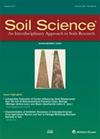Miniaturised visible and near-infrared spectrometers for assessing soil health indicators in mine site rehabilitation
4区 农林科学
Q2 Agricultural and Biological Sciences
引用次数: 5
Abstract
Abstract. Mining can cause severe disturbances to the soil, which underpins the viability of terrestrial ecosystems. Post-mining rehabilitation relies on measuring soil properties that are critical indicators of soil health. Soil visible–near-infrared (vis–NIR) spectroscopy is rapid, accurate, and cost-effective for estimating a range of soil properties. Recent advances in infrared detectors and microelectromechanical systems (MEMSs) have produced miniaturised, relatively inexpensive spectrometers. Here, we evaluate the spectra from four miniaturised visible and NIR spectrometers, some combinations, and a full-range vis–NIR spectrometer for modelling 29 soil physical, chemical, and biological properties used to assess soil health at mine sites. We collected topsoil samples from reference, undisturbed native vegetation, and stockpiles from seven mines in Western Australia. We evaluated the spectrometers' repeatability and the accuracy of spectroscopic models built with seven statistical and machine learning algorithms. The spectra from the visible spectrometer could estimate sand, silt, and clay with similar or better accuracy than the NIR spectrometers. However, the spectra from the NIR spectrometers produced better estimates of soil chemical and biological properties. By combining the miniaturised visible and NIR spectrometers, we improved the accuracy of their soil property estimates, which were similar to those from the full-range spectrometer. The miniaturised spectrometers and combinations predicted 24 of the 29 soil properties with moderate or greater accuracy (Lin's concordance correlation, ρc≥0.65). The repeatability of the NIR spectrometers was similar to that of the full-range, portable spectrometer. The miniaturised NIR spectrometers produced comparably accurate soil property estimates to the full-range portable system which is an order of magnitude more expensive, particularly when combined with the visible range sensor. Thus, the miniaturised spectrometers could form the basis for a rapid, cost-effective soil diagnostic capacity to support mine site rehabilitation and deliver significant positive economic and environmental outcomes.用于评估矿区修复土壤健康指标的小型化可见和近红外光谱仪
摘要采矿可能对土壤造成严重干扰,而土壤是陆地生态系统生存的基础。采矿后恢复依赖于测量土壤特性,这些特性是土壤健康的关键指标。土壤可见-近红外光谱(vis-NIR)是一种快速、准确、经济有效的估算土壤性质的方法。红外探测器和微机电系统(mems)的最新进展已经生产出小型化、相对便宜的光谱仪。在这里,我们评估了四个小型化的可见光和近红外光谱仪,一些组合,以及一个全范围的可见光-近红外光谱仪的光谱,用于模拟29种土壤物理,化学和生物特性,用于评估矿区土壤健康。我们从西澳大利亚州的七个矿山中收集了参考、未受干扰的原生植被和库存的表土样本。我们用7种统计和机器学习算法评估了光谱仪的可重复性和光谱模型的准确性。可见光光谱仪的光谱可以估计沙子、淤泥和粘土,其精度与近红外光谱仪相似或更好。然而,来自近红外光谱仪的光谱可以更好地估计土壤的化学和生物特性。通过结合小型化的可见光和近红外光谱仪,我们提高了土壤性质估计的准确性,其结果与全量程光谱仪的结果相似。微型光谱仪和组合预测29种土壤性质中的24种具有中等或更高的精度(林的一致性相关系数,ρc≥0.65)。近红外光谱仪的重复性与全量程便携式光谱仪相似。小型化的近红外光谱仪与全范围便携式系统相比,产生了相当精确的土壤性质估计,而全范围便携式系统的价格要贵一个数量级,特别是当与可见距离传感器结合使用时。因此,小型化光谱仪可以构成快速、具有成本效益的土壤诊断能力的基础,以支持矿区的恢复,并产生重大的积极的经济和环境成果。
本文章由计算机程序翻译,如有差异,请以英文原文为准。
求助全文
约1分钟内获得全文
求助全文
来源期刊

Soil Science
农林科学-土壤科学
CiteScore
2.70
自引率
0.00%
发文量
0
审稿时长
4.4 months
期刊介绍:
Cessation.Soil Science satisfies the professional needs of all scientists and laboratory personnel involved in soil and plant research by publishing primary research reports and critical reviews of basic and applied soil science, especially as it relates to soil and plant studies and general environmental soil science.
Each month, Soil Science presents authoritative research articles from an impressive array of discipline: soil chemistry and biochemistry, physics, fertility and nutrition, soil genesis and morphology, soil microbiology and mineralogy. Of immediate relevance to soil scientists-both industrial and academic-this unique publication also has long-range value for agronomists and environmental scientists.
 求助内容:
求助内容: 应助结果提醒方式:
应助结果提醒方式:


